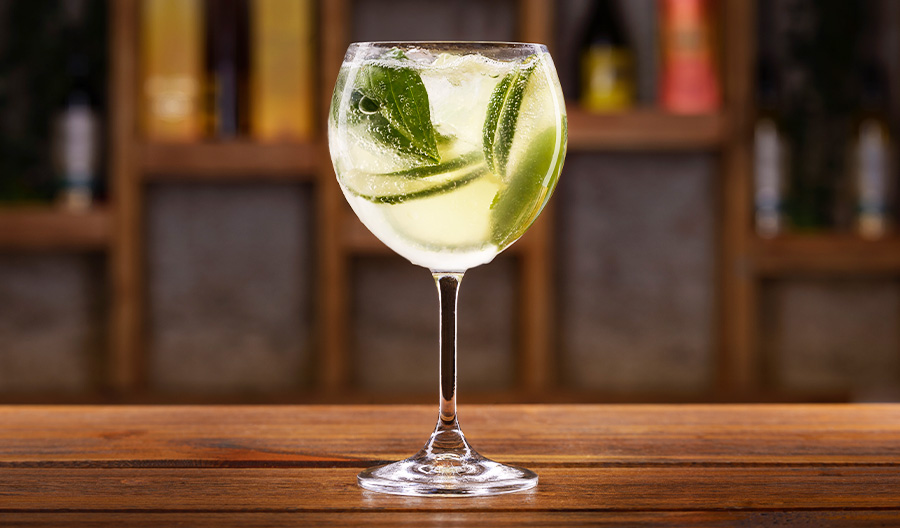Sure, vodka and gin may look the same, all clear and crisp in the glass. They’re used in some of the same drinks, too—notably, the iconic martini. But bartenders have strong opinions about which spirit is best. To put this age-old debate to rest, we reached out to pros to answer the all-important question: Would vodka or gin be victorious in a smackdown?
It is going to be quite the fight. Let’s get ready to rumble!
Vodka vs. Gin: What’s the Difference?
In a word, the main difference between vodka and gin is juniper. There’s more to it than that (we’ll get to the deep-dive details later), but at a minimum, vodka usually tends to have a neutral flavor profile, while gin is flavored with pine-y juniper berries, among other botanicals. Often, the difference in those flavors dictates how bar pros select bottles and mix them in drinks.
Vodka is versatile and mixes well with most ingredients. Further, its clean, crisp taste appeals to many palates.
By comparison, gin’s dominant flavor is juniper—as required by regulations in the U.S., England, and elsewhere. If you don’t love juniper, you won’t love gin. But many bartenders favor it.
Juniper is a flavor unique to itself. It’s satisfying in its intensity by itself and enhances most other flavors it plays with, including bitter, floral, sweet, herbal, and citrusy flavors.

Vodka vs. Gin: How Are They Made?
Like most spirits, gin and vodka start with raw materials (both can be made from just about any base ingredient), to which yeast is added to start fermentation. After fermentation, the liquid is distilled, transforming it into a spirit.
Both gin and vodka producers have a great deal of latitude. They can be made in any country and use pretty much any raw material and type of still. But after distillation, that’s where things start to diverge.
Vodka often is re-distilled—sometimes multiple times. It’s filtered, often multiple times with different materials and techniques in pursuit of absolute neutrality. (That said, some distill and/or filter minimally.)
Gin, by comparison, is all about the flavorings, aka “botanicals.” Juniper, of course, is number one. But it’s rarely the only botanical in the mix. Coriander, citrus, angelica, and orris root are among the most frequently-used gin botanicals. However, producers use ever-more-complex formulas, deliberately engineering gins to have pronounced floral, citrus, vegetal, and even briny notes. Add to those styles piney London Dry or lightly sweetened Old Tom, and the diversity of gin becomes clear.
There are so many botanical breakdowns that gin is never boring. Depending on the base distillate, the amount of juniper, the rest of the herbs, spices, citrus, or floral elements used, you can really have fun with this category.
Point: Gin—because there are so many options.
Vodka vs. Gin: Martinis
Here’s where it starts getting heated: Which is better in a martini, vodka or gin?
The classic martini wears the crown forever and always, since gin and vermouth were created to be soulmates. Add to that gin-based variations like the Martinez and Bijou.
Point: Gin. The classic martini rules.
Vodka vs. Gin: Other Drinks
Naturally, martinis only represent a fraction of the cocktail universe.
When it comes to mixing, vodka shines. Vodka mixes well with a variety of other ingredients, including fruit juices, sodas, and syrups. It can also be used to create infused spirits, adding flavors like citrus, berries, or herbs. Specific drinks to try include the Cosmopolitan, Bloody Mary, Moscow Mule, and Lemon Drop.
Of course, gin has its own cocktail canon, with the gin and tonic (G&T) being the most ubiquitous.
Tonic was made to pair with gin. The quinine and chinchona [two bittering agents found in tonic] are actually made sweeter by the juniper. The pairing of G&T is sublime and there’s no such thing as a “bad” G&T. The gin and tonic is a most satisfying safe bet.
Point: Vodka. Versatility wins the day.
Vodka vs Gin: Calories
According to the 2020–2025 Dietary Guidelines for Americans put forth by the National Institutes of Health, vodka and gin both have 97 calories in a 1 ½-ounce serving, assuming both are 80-proof. (See also the NIH’s Alcohol Calorie Calculator for further detail.) For those counting calories, the portion size and what’s mixed with the spirit makes a greater difference than selecting vodka or gin.
Point: Stalemate. If you care about calories, go to the gym.
Vodka vs Gin: And the Winner Is…
It’s worth noting that some people may not enjoy the taste of gin due to its characteristic juniper flavor, which can be quite strong and distinctive. Additionally, some individuals may have adverse reactions to certain botanicals or ingredients commonly used in gin.
Vodka has its own place in our cocktail ecosystem and is respected for that. In fact, sometimes “a neutral item” is necessary. A vodka soda is a cocktail for those who want to forget you’re having a cocktail.
The ultimate winner in our vodka vs gin smackdown? Gin, by a hair. Yet, vodka remains the world’s most popular spirit (until it’s usurped by tequila, anyway). Still undecided? May we suggest mixing a Vesper, which includes both vodka and gin.

